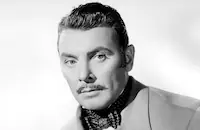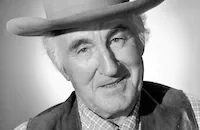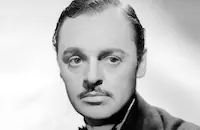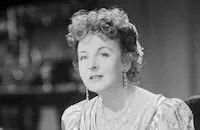The Old Maid

Brief Synopsis
Cast & Crew
Edmund Goulding
Bette Davis
Miriam Hopkins
George Brent
Jane Bryan
Donald Crisp
Film Details
Technical Specs

Synopsis
In the 1860's, on the day of Delia Lovell's wedding to the stuffy but socially prominent Jim Ralston, the impulsive Clem Spender, to whom Delia had been engaged, reappears after a two-year absence. Delia's cousin Charlotte, who has always loved Clem, takes pity on the young man and slips away to console him, returning home very late at night. The next day, Clem enlists in the Union army and soon after dies on the battlefield. Four years later, Charlotte has opened a home for war orphans, among whom is Tina, Charlotte and Clem's own daughter. Charlotte hides her disgraceful secret until the day she is to wed Jim's brother Joe, when she confesses her motherhood to Delia. Delia, who still loves Clem, spitefully destroys Charlotte's chance to marry Joe, and Charlotte retreats into seclusion. She reappears six months later, after Jim has died in a riding accident, and accepts Delia's invitation to move into the Ralston mansion with Tina. Fifteen years later, Tina, now grown, considers the kind and loving Delia to be her mother, while Charlotte has developed into a sullen and miserable woman who is constantly critical of her daughter. When Tina falls in love with a boy from a socially prominent family, Delia adopts her legally to provide her with a name and station in life, but on the eve of the wedding, Charlotte insists upon disclosing Tina's true identity. However, as she goes to Tina, Charlotte discovers that she cannot bring herself to destroy her daughter's happiness and remains content to stand in the background with her motherhood forever hidden.

Director

Edmund Goulding
Cast

Bette Davis

Miriam Hopkins

George Brent

Jane Bryan

Donald Crisp

Louise Fazenda

James Stephenson

Jerome Cowan

William Lundigan
Cecilia Loftus

Rand Brooks
Janet Shaw
Dewolf Hopper
Marlene Burnett

Doris Lloyd
Frederick Burton
Rod Cameron
Crew
Al Alleborn
George Amy
Henry Blanke
Leo F. Forbstein
Hugo Friedhofer
Tony Gaudio
Robert Haas
Orry-kelly
C. A. Riggs
Casey Robinson
Max Steiner
Jack Sullivan
Jack L. Warner
Perc Westmore

Photo Collections
Videos
Movie Clip



Trailer
Film Details
Technical Specs

Articles
The Old Maid
Bette Davis was fresh from the successes of Juarez (1939), Dark Victory (1939) and her Oscar-winning Jezebel (1938). The director, Edmund Goulding, had already guided her through two films (and would work with her again on The Great Lie in 1941). Jane Bryan, playing her daughter, had previously costarred with Davis in three films; the actresses were to remain lifelong friends.
But there were two very complicated relationships on the set. One was with her leading man, George Brent. He was to costar with Davis in a total of ten films and, in the early 1930s, he and Davis had indulged in a passionate affair (at a time when both were married to others). That had, happily, settled into a comfortable friendship by the time The Old Maid began shooting in March of 1939. The real fly in the ointment was Davis' female costar - the first time since becoming a star that she'd had to share the screen with another woman. Playing cousin Delia was the brilliant, Savannah-born actress Miriam Hopkins, who had earned praise on Broadway and in such films as Becky Sharp (1935) and Dr. Jekyll and Mr. Hyde (1932).
Bette Davis started filming with ill feelings: "I was never mad about the part," she admitted in her memoirs. She'd asked the studio if she could play both female roles, in a split-screen effect. Instead, the more colorful role--fluttery, selfish Delia--went to Hopkins. Hopkins, in turn, resented Davis for winning an Oscar as Jezebel--a role Hopkins had played on Broadway. The fact that Hopkins was in the midst of a divorce from director Anatole Litvak made her no easier to deal with on the set.
Davis had never before encountered an actress who dared to pull rank on her set, but Miriam Hopkins had no shame. Davis later recalled that while she was uttering her lines, Hopkins would go into a daze: "Her restless little spirit was impatiently awaiting her next line, her golden curls quivering with expectancy." Rather than fighting back, Davis cleverly sweet-talked director Goulding into trimming Hopkins' best scenes. She also indulged in the occasional "fainting spell," holding up the expensive production. But both actresses were, above all, professionals--and they made their mutual antipathy work onscreen.
When interviewed on the set, Hopkins batted her eyes sweetly and told reporters, "It makes a good story when women have feuds on their pictures . . . Somebody thought it would be good publicity for Bette and me to have a feud." Davis, in turn, said in icy tones "Hoppy and I are going to get a couple of pairs of boxing gloves and pose for a picture glowering at each other." She knew full well that being referred to as "Hoppy" alone was enough to send Hopkins into a tantrum.
Happily, though, both actresses came out winners. Davis gives one of her more restrained and tragic performances as the bitter old "aunt," her stillness accentuating her eyes and her voice. Hopkins, in turn, shines as the selfish, terrified woman who steals the love of her cousin's child. The Old Maid was one of the great films--a financial and critical success--in a very impressive year in film history. So much so that Davis and Hopkins were given a rematch at Warner Brothers, as battling authors in Old Acquaintance (1943). Once again, the battle reached a fever pitch, to the point where half the studio crowded in to see the scene wherein Davis had to shake Hopkins till her teeth shook--such was Davis' enmity that she fondly recalled it as a slap in her autobiography. But, as other actresses (from Joan Crawford to Lillian Gish) were to prove, being disliked by Bette Davis was one of the best ways to spur her on to a good performance. The Old Maid and Miriam Hopkins are certainly proof of that.
Producer: Hal B. Wallis
Director: Edmund Goulding
Screenplay: Casey Robinson, Zoe Akins (play), Edith Wharton (novel)
Art Direction: Robert M. Haas
Cinematography: Tony Gaudio
Editing: George Amy
Music: Max Steiner
Costume Design: Orry-Kelly
Cast: Bette Davis (Charlotte Lovell), Miriam Hopkins (Delia Lovell Ralston), George Brent (Clem Spender), Donald Crisp (Doctor Lanskell), Jane Byran (Tina), Louise Fazenda (Dora), James Stephenson (James Ralston), Jerome Cowan (Joe Ralston), William Lundigan (Lanning Halsey).
BW-95m. Closed captioning.
by Eve Golden

The Old Maid
Quotes
Trivia
Humphrey Bogart was originally cast as the male lead, but dismissed after four days' filming.
The Pulitzer Prize-winning play opened in New York City, New York, USA on 7 January 1935 and had 305 performance. The leads were played by Judith Anderson and Helen Menken. 'Ernst Lubitsh' bought rights to the play, intending to star both Anderson and Menken in a Paramount production, but Warner Bros. bought the rights from him in January 1939.
To get the effects of aging, Bette Davis didn't wear any eye makeup or lipstick, and makeup artist Perc Westmore used a pale, ashen base on her face.
Notes
According to a 1935 news item in Los Angeles Times, Ernst Lubitsch bought Akin's Pulitzer Prize winning play with the intention of directing Judith Anderson and Helen Menken in a Paramount production. A news item in Hollywood Reporter adds that Warners entered into negotiations to buy the rights to the play from Paramount in January 1939. This picture marked the last screen appearance of actress Louise Fazenda. A news item in Hollywood Reporter notes that Bogart was forced to give up the role of "Clem Spender" in this picture to appear in Dust Be My Destiny. Although the news item states that no footage had been shot prior to Bogart's departure, direction on the film had begun one week prior to his departure. Modern sources state that Bogart was replaced by George Brent in the role of "Clem Spender" because of Bogart's poor performance after two days of shooting. Modern sources also add that to achieve the effect of aging, makeup artist Perc Westmore used a pale, ashen base on Bette Davis' face and used no eye makeup or lipstick, thus creating a "withered" look. In October 1939, Loretta Young and Miriam Hopkins starred in a Lux Radio Theatre version of the play.















